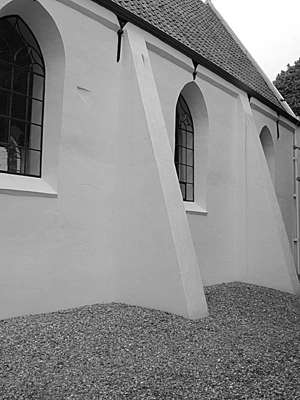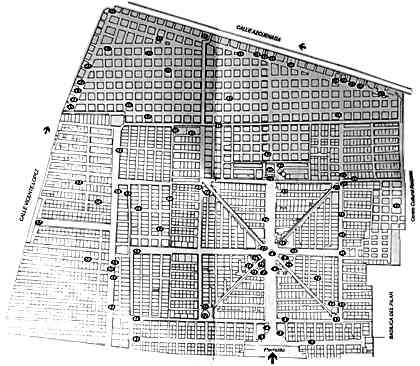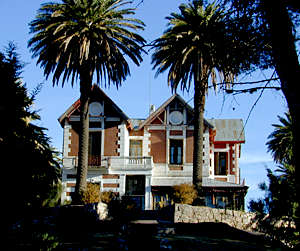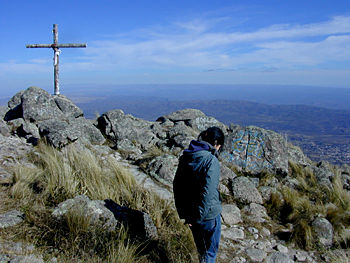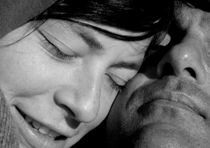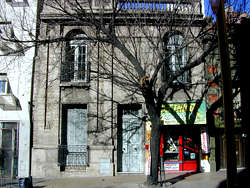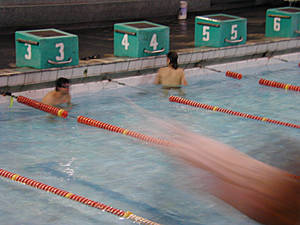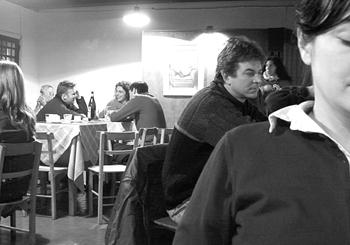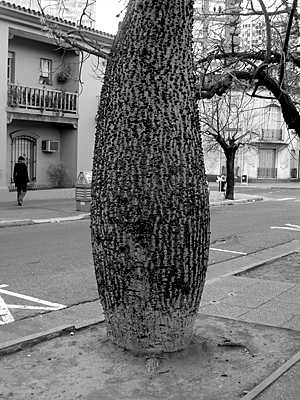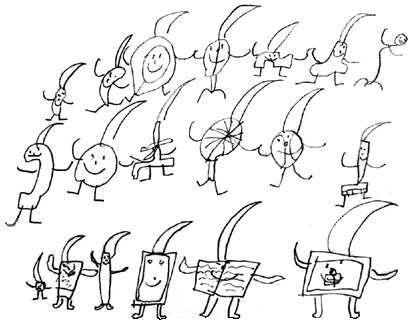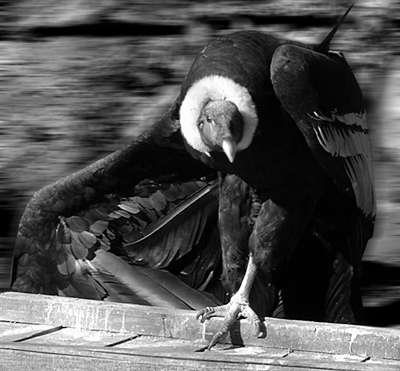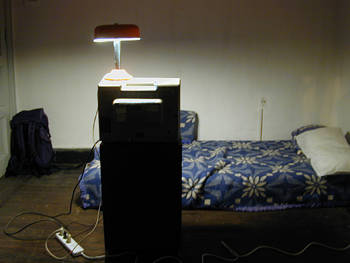|
|

|
||||||||||
|
|
Present Past Subjects Projects Misc |
JUNE 2002
The Baphomet Pierre Klossowski's The Baphomet. Concerning 'The Baphomet', Steven Shaviro says this in Chapter 14 of Doom Patrols:
And in a related note, worldartists.com has this to say concerning Raul Ruiz's film The Hypothesis of the Stolen Painting (1982).
Read PKD's third published novel, 'The Man Who Japed' (1956) yesterday. Contains a section of ontological vertigo where the protagonist suddenly finds himself living the life of another man in another world. PKD is very good at this. (Compare the protagonist's S. divinorum-like trip wearing a toy cowboy suit in PKD's short story 'War Game' (1959).) Fuck D. Hirst's 'The Physical Impossibility of Death in the Mind of Someone Living' (1991) -- the famous piece with the shark -- for he got it COMPLETELY wrong.
30 May 2002. The churchyard at Breede. The Terror of Poe Premature Burial In The Nineteenth Century
E. A. Poe, The Premature Burial
(In future I promise to take more risks.) More than 1 year ago... confessing to the vagina. More than 2 years ago... how zen masters are like mature herring. More than 3 years ago... christmas in june. More than 4 years ago... het komt wel goed. The Impossibilty of Death I linked to it in passing during the DasArts block but since I've rediscovered it I want to link to it again. Kevin Fitzgerald's close reading of Maurice Blanchot's 'Thomas the Obscure': The Negative Eschatology of Maurice Blanchot R. and I agreed yesterday to use a couple books by John Dickson Carr as a research base for our upcoming film project. On the train home last night I started Carr's classic The Hollow Man (1935). Concerning the strange character Fley, Carr writes:
(Buenos Aires) Trans-Atlantyk The crossing took place at the night and was over before I knew it -- glancing outside I saw lights and realised with a shock that we were already flying over Brasil. The remaining hours passed slowly as we flew down the long coast, I alternately dozing off for a few minutes and then waking again, occasionally checking our position on the lcd screen above the fold-down tray. Patricio picked me up at the airport. And as we drove into Buenos Aires he showed me a 2 peso note (a federal bond, virtually indistinguishable from a federal note) and explained that if I received one in change I shouldn't accept it. Welcome to Argentina. (Buenos Aires) La Recoleta
The necropolis as labyrinth. (Córdoba) Córdoba has a zoo. We visited it today. N. (claiming that they were not getting enough to eat) fed the bears cookies... I joined a gym today. (Capilla del Monte)
La Casona. As Monday's a holiday (and N. can't work) we decided, upon the suggestion of someone at the Goethe Institute, to take off for a couple of days to Capilla del Monte, a town in the Sierras de Córdoba, about a 100 kms. north of the city. Capilla del Monte is a wild place, reputedly the past site of many UFO sightings and close encounters, it now enjoys a reputation as a center for 'mystical tourism'. Walking around the town, one wonders whether the 'new age ambience' is indeed an effect of such visitations or its cause; the proprietor of La Casona (our hotel), when we asked about the UFO's, suggested that the aliens had actually brought to the town a number of the local inhabitants. Besides yerba mate, 'boldo' is the name of another herb drunk as tea. 'Bay' leaf like shape. Tastes like medicine. We bought a bag. (Capilla del Monte)
View from the top (wide angle). Seven hour hike to the peak of Cerro Uritorco (1,979 meters). The silence up here, especially after Córdoba, is unnerving; in such an environment every sound -- the knife sawing at a rope, the dull thud of a heavy bag falling to the ground, the sound of a relieved horse tearing at the shrubbery with its teeth -- takes on import, focuses the attention. Near the peak we see an eagle sitting on a rock; reaching the top, a pair of larger birds, blacker with white wing tips, vulture-like. The roar of wind passing through trimmed feathers as they swoop down to land and sun themselves sounds remarkably like a jet aircraft. Are these condors? Later, on the noisy minibus home, the radio announcer's speed-Spanish makes me want to buy a radio.
View from the top (close up). (Córdoba)
Ituzaingó 511 C (our apartment is behind the two arched windows). (Córdoba) Consider the 'locked room': Inside it either an event happens which shouldn't have happened (such as a murder or a robbery where we have to assume a perpetrator who has passed into the locked room, produced the action in question and then passed out again without disturbing the locks), or someone enters it and stays (leaving the locks intact), or someone who escapes (again leaving the locks intact). A variation would be the scene in David Lynch's 'Lost Highway' where one prisoner is switched for another in a locked prison cell. Consider the locks: To what degree is the room locked? Is it locked in the everyday sense, that is, locked to prohibit physical access (or departure), or is it more firmly locked so to prevent any form of physical intervention? Or even more securely: can an external observer 'see' into the room (either through a window or via closed-circuit video monitoring or some other sensing apparatus) or is the room entirely closed to all senses? (Consider the genie locked in the bottle. The bottle is opaque, studded with jewels. We cannot see inside. We can only wonder what the genie is doing in there, whether or not, trapped inside, the creature even exists...) Does the 'locked room' invite escape or refuge? Dr. Fell on the romance of the safe haven:
(Córdoba) One's timeline becomes confused... My second winter solstice in six months. Who'd have thought? "What has happened has not happened: thus spoke patience, that the end might not be hurried." (Blanchot) (Córdoba) Natatorio Gabriel Taborin
Rehearsal of N.'s theater piece. (Córdoba) After two cloudy and damp days (the only two since my arrival in Argentina) today the sun's again shining. Yes it's cold, but the sun is shining.
Hmm... two weeks ago with the help of Patricio Larrambebere and Javier Martínez I toured the librerías of Buenos Aires searching for a copy of Borges's recently published Collected Fictions (in english). Everywhere we found copies of his Selected Non-Fictions and Selected Poems but not the Collected Fictions. Now, ironically, here in Córdoba I suddenly find myself in need of his essay 'The Thousand and One Nights' and kick myself for not having bought the selected non-fiction when I had the chance -- for of course here, 710 km. from Buenos Aires, it is nowhere to be found. Luckily however, I have found Seven Nights, a slim 'New Directions' volume containing the lectures that Borges gave at the Teatro Coliseo during the winter of 1977 and containing the aforementioned essay. Like Borges, I too have a Burton translation at home (in fact I have two, a 10 volume set in Rotterdam, obtained recently, and a 16 volume set in Vancouver, obtained more than 20 years ago) but unlike Borges I do have every intention of reading it. "One feels like getting lost..." Truly, one often feels like getting lost, getting completely lost, in the labyrinth, in the infinitely locked room, in the maze of twisty little passages, all alike. One could say: Yea, take me away from all this life and let me wander forever dead. Forever dead in the mirrored room, the funhouse, in dreams, in the bardos. A mind-body forever voyaging. Perhaps getting lost is the ultimate refuge. When all else fails. (One dies when all else fails. And one seems forever dying.) (Córdoba)
Sunday 19:00 hrs. Cafe el Paseo de los Artes. (Córdoba)
Sunday 17:30 hrs. (In a world inhabited by tree spirits this has got to be a hungry ghost tree.) Cold weather lunch: blue cheese, radish and red chili sandwiches (chilies very hot and sweet, bought this morning from the Bolivian woman sitting on the corner of Ituzaingó and Crisol.) (Córdoba) Funny. The more I walk around this neighborhood the more I notice. While I enjoyed the references to escapology, Dr. Fell's locked room lecture, and the device whereby stand-ins for the novel's readers are made to appear in the story (as Rampole and his wife Dorothy), in the long run I found John Dickson Carr's The Hollow Man somewhat tedious. Why? Too many suspects and not enough plot? Too much puzzle and not enough book? I don't know... for many readers the emphasis on the puzzle might be precisely the reason for the book's appeal, hmm? Anyway, as previously agreed with R., (in preparation for our upcoming film project), I am now a third of the way through my second book by Carr, The Corpse in the Waxworks (1932), featuring the French detective Bencolin, a vaguely Twin Peaks like mystery, and, already in Chapter 1, a grand view of the wax museum:
Interesting how an artist's practice may actually flirt with the very thing he or she fears most. (Córdoba) Coordinates. Why are specific references to specific locations so damned fascinating? What is it about a precise reference (apart from its potential function as an instruction, a directive) that makes it so compelling, so significant? Borges, in his lecture on nightmares, claims that all his nightmares are situated on street corners in Buenos Aires. He provides us with two coordinates, the corner of Laprida and Arenales, and the corner of Balcare and Chile, and then goes on to state that in his nightmares these locations do not need to appear to be actual street corners. They could be "completely different. They could be mountain paths or swamps or jungles, it doesn't matter: I know that I am on a certain corner in Buenos Aires. I try to find my way." To get lost again. To locate oneself precisely, in either reality or fiction, seems a good way to achieve this. The dream map. Kneeling on the pavement in front of the Centro Inmobiliario (Rondeau 74), Brian Mamani and his sister draw pictures on the back side of printed sheets of paper. It is very late for children to be on the street. Shouldn't they be home, in bed (especially given this cold)? Where are their parents? Where do they live? Brian says his drawings are for sale. N and I search through a pile and choose one carefully. We hold it up to show him and ask, "How much?" Brian shrugs and says how ever much we wish to pay. We give him a peso.
Brian Mamani, 'Dancing Fixtures' (detail), 2002. (Córdoba) Animal Kingdom
Thursday, 16:00 hrs. At the zoológico. As I walked past the cage the first thing I noticed were the large gnawed joints of meat and the black cat. The cat stood motionless next to the bones. It was a normal cat and not very large either, and I remember wondering at this, and thinking that the creature lurking around here was obviously a carnivore of some sort. Did not this little cat fear for its life? (Córdoba)
Video set-up in the Ituzaingó apartment. Follow-up. Another black cat. This time at the beginning of the hospital bed scene (Nick's reconciliation with his daughter) in Wim Wenders' film, 'Nick's Film - Lightning over Water' (1981). Lightning Over Water is a film about Nicholas Ray's impending death, Wender's relation to Ray, and the making of a film (the reality of dying staged for film). In many ways Lightning Over Water is more a film script than a film. In one scene Ray reads to Wenders a treatment he's written (a film script within the film script): "This is a film about a man who is an artist. He's 60 years old. He's made a lot of money in the art world on his early paintings. He's not been able to sell his current output -- and he's got another need besides money which is to regain his own identity as fully as he can before he dies. He's fatally ill with cancer and knows it. "To regain his own paintings he steals them as well as forges his own work and tries whenever possible to replace what he steals hanging in museums with his forgeries. This is what he enjoys doing the most." Many stages within the stage. (En route) Note to myself: Make some notes on the current financial crisis (and the various currencies and forgeries in circulation here at the moment). Need to find a good informant concerning this. Perhaps talk with Pedro?
ALAMUT.COM is artist owned and operated.
|
|
||||||||
